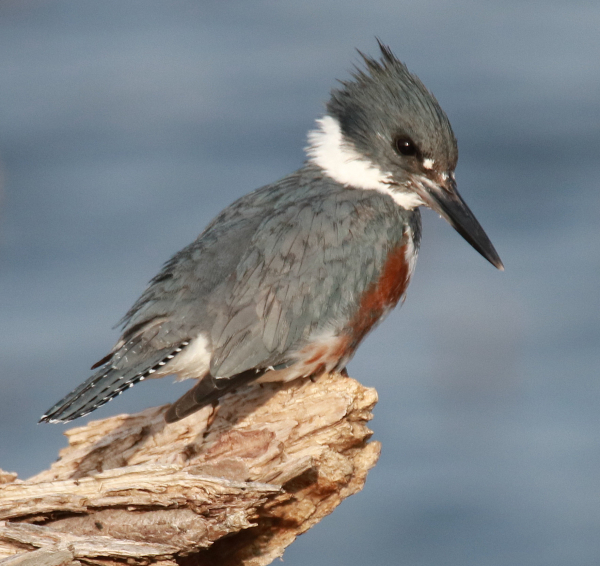
Kingfishers are usually very wary and difficult to approach – until you find an ambassador. That’s when everything changes as a bird photographer, when that special bird is not affected by your approach or your presence. After decades of seeing female Belted Kingfishers from afar, and photographing them from too far away, I remained patient. Certainly there were other birds to observe and photograph at closer quarters. Eventually the slightly smaller, slightly less colorful male kingfishers provided some close photo opportunities. But since I returned to rural Dakota from urban California, I have rarely seen a female Belted Kingfisher, much less have I had one close enough to photograph – until last week.
Ten days ago I had a couple opportunities to photograph the first Belted Kingfisher of spring in this area, a rare female, close to my office. I was delighted and shared one of the resulting photos in my Editor Afield article in last week’s issue. But realistically, the photos I took a week ago Monday were merely documentary because they were not as sharp as I would have expected. Even so, that was a breakthrough; I had some tight photos of a female Belted Kingfisher. I hoped she would persist in the area, but I didn’t see her again after Monday.
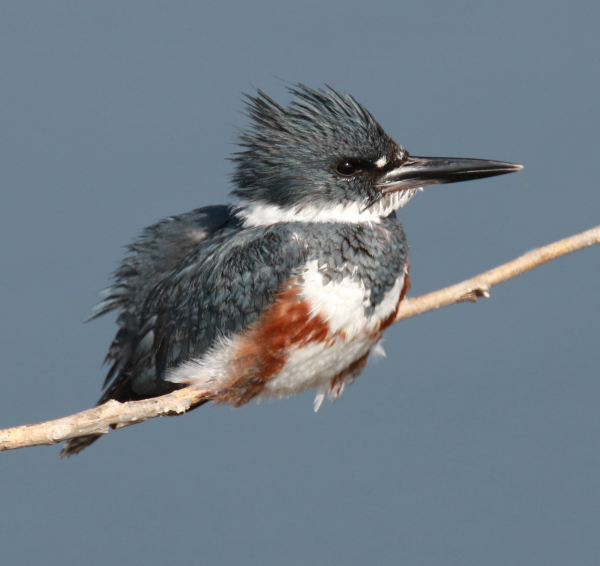
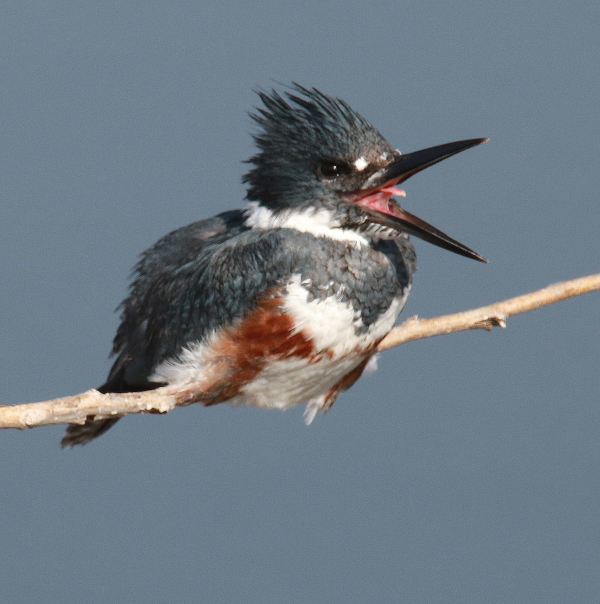
A broad beak stretch provided a different portrait treatment that required concentration and anticipation to document this fleeting moment.
|
With sunshine from horizon to horizon last Thursday, I hoped for some new photo ops, and had a few when I passed an apparent pair of Belted Kingfishers, a male and female, perched 10 yards apart at the edge of a marsh. I thought I would check on a nest site a mile farther, then return; but that didn’t happen. Just before I turned around a mile farther south, 11 miles south of home, I noticed another female kingfisher perched on the edge of a marsh near the road. As always, I approached slowly with the sun at my back, and stopped in a good position while the kingfisher perched on top of the broken snag of a tree trunk.
I took a couple quick photos, just in case the kingfisher might fly, but it appeared to be unconcerned with my position, and I continued to photograph and wait for the impressive female to show a little action. I switched my aperture from my usual f8 to f6 to try to blur the water in the background into a more uniform blue hue. A moment after that the bird went into fishing mode, dropping almost straight down, head first, and emerging from the water with a sizeable fish in its bill. Unfortunately, the perch where it landed was surrounded by a lot of background elements – a few tree branches and many cattails – making that setting less than attractive, photographically speaking.
I watched and waited as the female whacked the fish into submission and swallowed it. Without hesitation she dived into the water as if to bathe, then returned to the same perch to preen. While I waiting for the kingfisher to reposition to a perch with a better background, I checked the photos I had already taken to make sure the lighting, focus, and background were good. Eventually, the kingfisher flew to a low perch that appeared to be somewhat concealed behind thin tree branches. I repositioned as carefully as possible, and found there was an opening where I could get clear images of the kingfisher, which seemed to have gone into something of a restful mode after its big meal. In fact, that’s when the female went into cute mode, minimizing its size and taking advantage of the warm sun to dry its plumage.

This was the best photo setting, with perfect lighting at 4:30pm, although the kingfisher didn’t provide much action beyond the great portrait opportunities. Yet I was happy when it simply reversed its position on its perch to show its back for a couple photos as it looked to the side. The kingfisher was relaxed, and so was I, and I absorbed the nature surrounding me, the spring air, marsh bird calls, and the sight of a Great Egret, Lesser Scaup, Northern Shovelers, Blue-winged Teal, Mallards, a pair of Giant Canada Geese, Pied-billed Grebes, American Coots, Yellow-headed Blackbirds, and Double-crested Cormorants – a classic marsh environ in this area.
As it rested and digested, I eventually opted to break away from my kingfisher ambassador with the hope of finding other avian ambassadors during this prime light period – and I did. At one location I found my first Lesser Yellowlegs of the season, an American Avocet, and a couple flocks of Wilson’s Phalaropes that I keyed in on photographically for a while with fine successes and lots of fun action. Down the road piece, I witnessed something I’ve never seen before; a pair of Wilson’s Snipe displaying, each using its flared and elevated tail. As they walked in front of one another, they twisted their tail so it pointed at the other bird, best showing the rufous-orange color of the dorsal side of the tail. It was quick exciting to witness and a bit trying to photograph because the snipe made their way through grass and in and out of good light for a couple minutes before moving to the next display site.
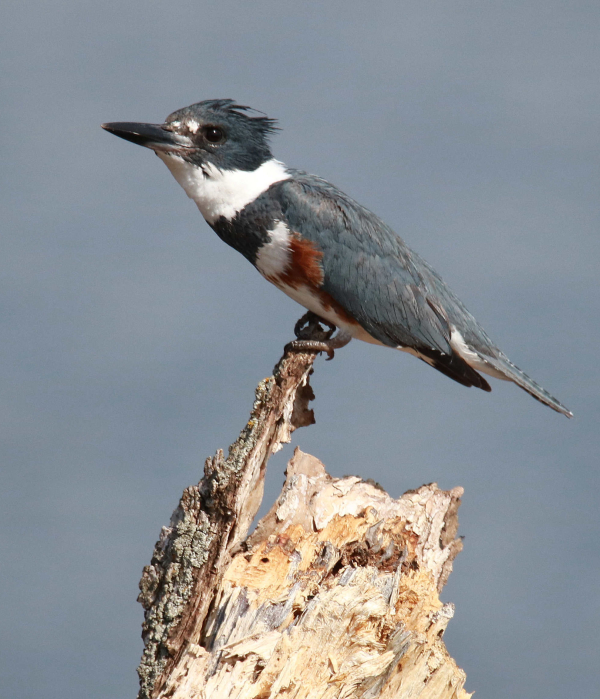
As Paul watched for the kingfisher’s next move through his camera lens, the ambassador showed it was alerted by holding its plumage close to its body to make it look smaller, an action that might have been a response to the sight of a potential predator.
|
By then, feeling like I already had an abundance of photo ops, I couldn’t resist checking back on the female kingfisher. Sure enough, she was still in the same area, perched on the snag of a big upright branch on a flooded tree. I slipped into position with a little lower angle of sunlight and took a couple initial photos. Then, as I watched for the next move through my camera lens, the kingfisher showed it was alerted by holding its plumage close to its body to make it look smaller, an action that might have been a response to the sight of a potential predator. I took a quick photo to document the change of posture, then took one more as the kingfisher took flight, at the apex of its first forward wing flap – a photo that made me exclaim out loud when I viewed the photo among the others I took last Thursday. Obviously, it was extremely exciting to see the image, taken at 1/2000 of a second.
Species ambassadors are all around us, although among less common species they can be quite rare. I waited several decades for this female Belted Kingfisher to become my representative ambassador. When we find a bird that is especially trusting and permits us to spend time within its immediate realm to photograph it acting naturally, treat it with respect and enjoy the opportunity. But our behavior can affect any given bird’s behavior, and we don’t necessarily need an ambassador to get good photo ops. Often if we move slowly, indirectly, keeping a low profile when possible, whether on foot or in a vehicle, we can periodically get within telephoto lens range of birds we are interested in photographing.
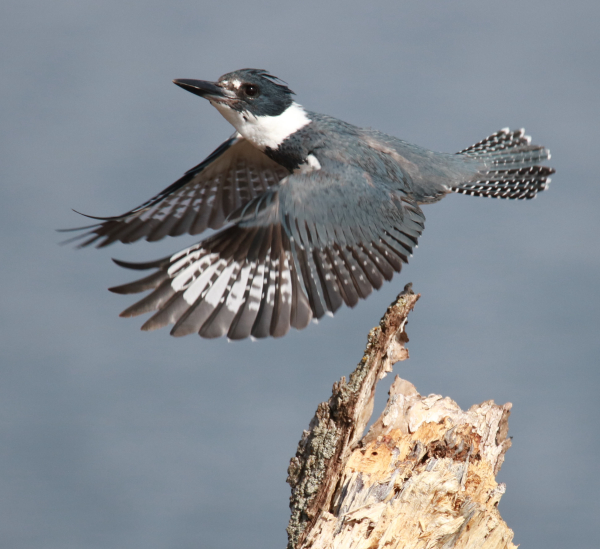
Of course, there are many birds that take flight before we can even make an approach, but that’s what birds do, and that’s part of what makes photographing birds so challenging, and so rewarding when we are able to take some nice photos. And along the way, we occasionally find an ambassador among species we’ve hoped to photograph and tried to photograph for years, even decades. Believe me, you will never forget species ambassadors you find and photograph – they are exceptional birds that provide photos that you can share, and even use to teach about birds, birding, photography, and natural adventures. They can even illustrate your bird photo tales you write and share with friends and family via email, text, snail mail, meta, etcetera. Be aware this spring, as a species ambassador may be just around the corner, and it may even be a female Belted Kingfisher. Good Luck!
Article and photographs by Paul Konrad
Share your bird photos and birding experiences at editorstbw2@gmail.com